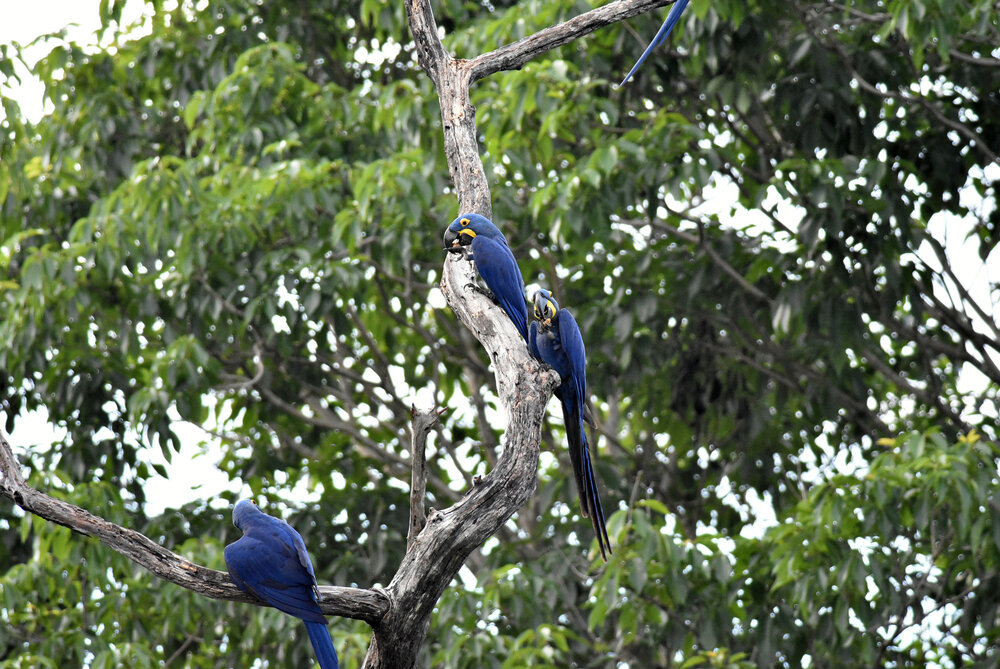
Hyacinth macaw
Zoo Berlin is helping to protect hyacinth macaws in Bolivia.
Project facts
- Project name
Hyacinth Macaw Program
- Species
Hyacinth macaw (Anodorhynchus hyacinthinus)
- IUCN threatened status
Vulnerable (VU)
- Project location
San Matías Protected Area, Bolivia
- Greatest threat
Illegal pet trade; loss of habitat
- Response
Curbing trafficking; protecting habitats; educating the local population
Threat Categories of IUCN


A true blue star of the Zoo
With their impressive size and brilliant blue plumage that contrasts strikingly with yellow patches around the beak and eyes, hyacinth macaws are the superstars of Zoo Berlin’s World of Birds. Growing up to one metre in length and weighing in at over 1.5 kg, hyacinth macaws are the world’s largest flying parrot species. Zoo Berlin aims to use the popularity of these magnificent birds to draw attention to the threat facing the species in the wild. The first hyacinth macaws came to Berlin in the 1870s, and the parrots have been a permanent presence at Zoo Berlin since 1964.
At home in the tropics
Hyacinth macaws live in the tropical rainforests of South America. The parrots can be found in three different regions of Brazil, with the majority inhabiting the Pantanal wetland area. They can also be spotted in eastern Bolivia, where numbers seem to increase during the dry season. It is assumed that the birds fly west here from Brazil. Currently, Bolivia is thought to be home to around 300 of the parrots. There have also been isolated sightings of hyacinth macaws in Paraguay.
Illegal trafficking and the destruction of the rainforest
Hyacinth macaw numbers plummeted during the 1980s, and an estimated 10,000 of the birds have been caught illegally and were sold as pets. The parrots are also hunted for their feathers and their meat. The ongoing destruction of the South American rainforests is another reason for the decline in numbers as it robs the macaws of their home. In recent years, deforestation has intensified in Brazil: between August 2015 and July 2016 alone, 8,000 km² of primeval forest was destroyed – that is an area ten times the size of Berlin.
Clear goals in Bolivia
Zoo Berlin has been supporting the World Parrot Trust’s (WPT) Hyacinth Macaw Program in Bolivia since 2016. The WPT has been championing the cause of these fabulous blue birds for decades, and therefore possesses a great deal of expertise and experience in conservation projects in the region. The Hyacinth Macaw Program’s main goals are mapping the areas used by the macaws; developing and conducting measures to monitor hyacinth macaw numbers in these areas; taking stock of nests and possible nesting sites; helping authorities curb the illegal trade in hyacinth macaws; carrying out educational work in schools and other educational establishments; and encouraging eco-tourism. The project also releases confiscated birds back into the wild where possible.



Conservation efforts are taking effect
The current Hyacinth Macaw Program was launched in the San Matías Protected Area in Santa Cruz Department, Bolivia in 2016. The WPT and Zoo Berlin are working closely with a number of local and international organisations on the project, which has already experienced a great deal of success. Thanks to the WPT’s ongoing conservation efforts, hyacinth macaw numbers have stabilised in recent years, and in some regions numbers are even growing. As a result, in 2014 the IUCN downgraded the hyacinth macaw’s conservation status from “Endangered” (EN) to “Vulnerable” (VU).
Photos: © Hyacinth Macaw Program





